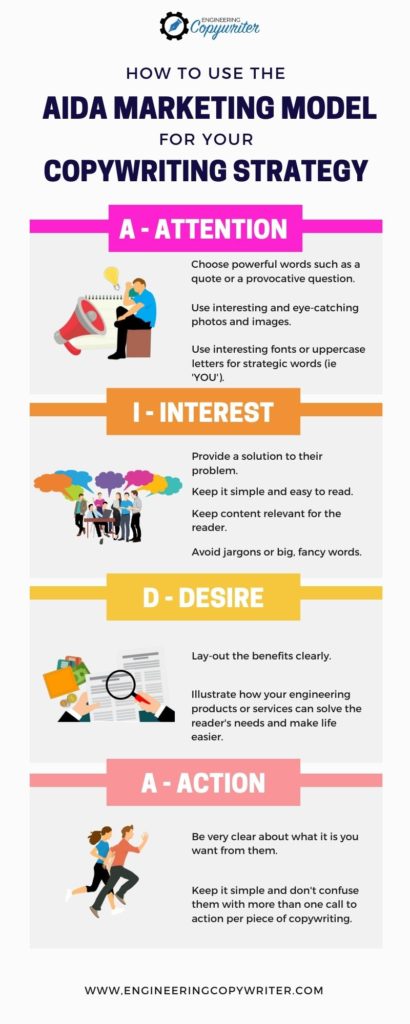
The AIDA marketing model is an effective method to improve the success of your copywriting. The letters stand for Attention, Interest, Desire, and Action. This is a succinct way to remember the framework within which every copywriter aims to write: firstly to grab your reader’s attention, then go on to build their interest while creating a desire for your product, and then finally moving them to take action. So in case you have always wondered about the letters AIDA, here’s a little more of what it’s all about and how you can make the most of it to succeed in your copywriting.

The AIDA marketing model is important because it allows you to align your marketing message with your buyer personas. Before incorporating AIDA into your copywriting, it’s important that you first have an in-depth understanding of your audience. What are your customer’s pain points? Are they looking for engineering software to alleviate that problem? What are their interests? Are they looking to expand their knowledge within a certain field?
Only when you have a firm grip on what motivates your audience can you effectively tailor your copywriting to directly appeal to the person ready and waiting to purchase your product or enquire about a service you offer.

Your very first goal is to attract the attention of your recipient so that they will pause long enough to open and read your email or blog. This is where your headline or subject line plays a vital role. Choose powerful words, perhaps an interesting font, or uppercase letters for strategic words such as ‘YOU’. Or you could pose a provocative question. Pictures and images can also be used to draw readers’ attention to your writing.
How to demand attention? As mentioned previously, in order to demand attention you will need to have a thorough understanding of your audience and customers. With that knowledge in hand, you can then develop focused, highly targeted content that solves their problems, highlights their interests, and ultimately enforces your marketing message.
Now that you’ve got their attention, you need to hold it long enough so that they keep on reading. Remember to make it all about them and their needs and how you can offer them something to make their lives better and easier. Speaking of easier, make sure that your text is easy to read — no jargon or big, fancy words — and stay away from long, heavy paragraphs. Keep your sentences short, and use bullet points and subheadings which can be scanned effortlessly.
How to spark interest? You can spark interest amongst your audience by providing a solution to their problems. Yes, you should keep it simple and easy to read, but you should adopt a storytelling approach that will encourage the reader to identify with the problem and ultimately lead them to seeking out a way to resolve it. As engineers, the creators of emerging technology, the predictors of the future, you have an unrivaled ability to tell a story. Move away from the ‘Once Upon a Time’ approach and into a story that entices the reader to think about the future.
This part usually unfolds simultaneously with keeping their interest, while you are building up a desire for your product as you go along. Don’t expect your readers to figure out all the benefits for themselves – lay it out clearly, telling them exactly how your service or product will save them time, effort, and frustration. This is where you aim to touch on a nerve or sweet spot and appeal to their personal needs and desires, bringing them smoothly to the next stage where they are ready to take a positive step in your direction.
How to ignite desire? In order to showcase the benefits of your product or service, you should illustrate how they fulfill your audience’s needs. For instance, you could achieve this through before and after photos of a civil engineering project. Essentially, your audience needs to see how you can enhance their lives.

The call to action is your cherry on the top. This is where you have been aiming all along, and now is the moment when your reader either does or doesn’t make a move. At this point you need to be very clear about what it is you want from them, whether they should visit your website, subscribe to your blog, or accept a free article in exchange for their email address. Whatever it is, keep it simple, and don’t confuse them with more than one call to action per piece of copywriting.
How to increase the chances of an action? When crafting your call to actions, you should consider how you would sell your products or services in person! You would use a sense or urgency, wouldn’t you? Marketers can create that sense of urgency online by offering time sensitive incentives such as discounts for a limited time.
Some people insert an extra point in the acronym, making it read AIDEA where the E stands for Evidence. In this day and age where people often want ‘proof’ before they accept something, you may need to pull out the hard facts, data, and of course statistics. If you don’t have any of those available, it might even be worth conducting a survey to support your claims, or create a case study with some glowing testimonials.
If you want to grab your customers’ attention, then let us write some fresh and relevant blogs for your website. Contact us today for a chat.
Content marketing helps marketers showcase their brand's value while also building trust with...
The digital age has transformed the way marketers engage with B2B audiences. As...